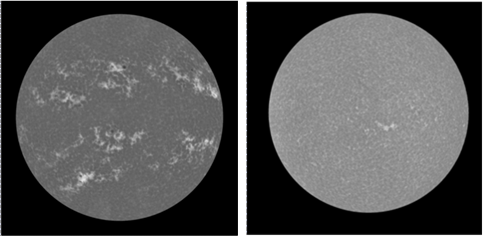
Disclaimer: Copyright infringement not intended.
Context
- A new methodology has been developed to analyze images of the Sun in white light, addressing issues related to temporal and latitudinal variations in observations.
- This innovative technique, known as the Equal Contrast Technique (ECT), holds the potential to provide accurate analysis of the historic time series of images of the Sun.
- It offers insights into the dynamics of the Sun, solar cycle variations, dynamo processes in the convection zone, and their impact on Earth's long-term climatic variations.
Details
Understanding the Need
- Observations related to the Sun often suffer from temporal and latitudinal variations due to instrument and sky conditions.
- The Sun exhibits numerous regions of weak magnetic field that vary over time, which can be studied using magnetograms and Ca-K line images.
- The Ca-K line intensity correlates strongly with the magnetic field intensity in the Sun's regions.
Challenges with Traditional Methods
- Temporal Limitations: Magnetograms have a limited availability for short periods, and instrument characteristics change over time, hindering the study of long-term variations.
- Data Inconsistencies: Different observatories around the world provide data with varying instrument configurations, leading to diverse results.
- Scattering of Results: Day-to-day variations in instrument settings and sky conditions result in scattered data, affecting the accuracy of analysis.
- Long-Term Variation Impact: Changing emulsions used to record images introduce long-term variations in the results.

Equal Contrast Technique (ECT)
- The ECT methodology, developed by scientists from the Indian Institute of Astrophysics, addresses the challenges associated with instrument and sky conditions.
- This technique compensates for temporal and latitudinal variations, ensuring more accurate and reliable results.
Applications and Benefits
- Solar Dynamics Study: ECT enables accurate analysis of long-term Ca-K line images, offering insights into the Sun's dynamics, magnetic field variations, and solar activity patterns.
- Solar Cycle Variations: By correlating derived plage area (bright regions in the sun's chromosphere) from Ca-K images with sunspot numbers, ECT can help unravel solar cycle variations and their implications.
- Dynamo Processes Exploration: The methodology aids in understanding dynamo processes in the convection zone of the Sun, contributing to solar physics research.
- Earth's Climate Impact: Accurate analysis of historic solar data assists in studying the effect of solar variations on Earth's climatic conditions over extended periods.
- Long-Term Correlation: The ECT's application to Ca-K images from the Kodaikanal observatory demonstrated excellent correlation between derived plage area and sunspot numbers over a century, even on a daily basis.
Magnetograms: Understanding Earth's Magnetic Field
- Magnetograms are graphical representations that depict the variations in Earth's magnetic field strength and direction over time.
- These recordings are vital tools for studying the Earth's internal processes, its interactions with the solar wind, and their impacts on various terrestrial and space phenomena.
Importance of Magnetograms
- Geomagnetic Field Monitoring: Magnetograms provide crucial information about the Earth's geomagnetic field, which is generated by the movement of molten iron in its outer core. This field not only plays a role in guiding navigation but also shields the planet from harmful cosmic radiation and solar wind particles.
- Space Weather Prediction: The variations in Earth's magnetic field are closely tied to space weather phenomena. Magnetograms help in predicting geomagnetic storms, which can disrupt power grids, satellite operations, communication systems, and navigation equipment.
- Understanding Earth's Interior: By studying changes in the magnetic field, scientists gain insights into the Earth's internal processes, such as the movement of molten iron and the dynamics of the outer core. This contributes to our understanding of plate tectonics, the Earth's magnetic reversals, and its overall geological evolution.
- Solar Wind Interaction: The Earth's magnetic field interacts with the solar wind – a stream of charged particles emanating from the Sun. Magnetograms aid in understanding these interactions, including how the solar wind affects the magnetosphere, ionosphere, and other atmospheric layers.
Components of a Magnetogram
- Magnetic Field Strength: The vertical axis of a magnetogram represents the strength of the magnetic field, usually measured in nanoTesla (nT) or gamma (γ). Distinct fluctuations indicate changes in geomagnetic activity.
- Time Axis: Magnetograms are plotted over time, typically in hours or days. Regular readings help identify short-term fluctuations and long-term trends.
- Directional Information: Magnetograms may include arrows or lines to indicate the direction of the magnetic field vector. This provides insights into the orientation of the field.
Recording and Data Sources
- Observatories: Ground-based magnetic observatories worldwide continuously monitor Earth's magnetic field using magnetometers. These observatories are part of global networks contributing to the study of geomagnetism.
- Satellites: Many satellites equipped with magnetometers orbit the Earth, capturing magnetic field data from space. These data help create a comprehensive picture of the Earth's magnetic field from various perspectives.
Technological Advancements
- Superconducting Magnetometers: These highly sensitive instruments measure tiny changes in magnetic field strength. They are used in both ground-based observatories and space missions.
- Satellite Arrays: Constellations of satellites provide more extensive coverage of Earth's magnetic field variations. The Swarm mission by the European Space Agency is a notable example.
- Real-time Monitoring: Advanced magnetometers and satellite networks enable real-time monitoring of space weather conditions, contributing to timely warnings about potential geomagnetic storms.

Conclusion
The Equal Contrast Technique (ECT) marks a significant advancement in analyzing historic time series of images of the Sun. By mitigating challenges related to instrument and sky conditions, this methodology opens avenues for reliable and accurate investigations into solar dynamics, solar cycle variations, and their implications on Earth's climate. The ECT's successful application underscores its potential for shaping our understanding of the Sun's behavior and its far-reaching effects on our planet.
Magnetograms serve as a window into the Earth's dynamic relationship with the Sun and its internal processes. By studying variations in Earth's magnetic field, scientists gain insights into geological and atmospheric phenomena, aiding in space weather prediction, understanding Earth's core dynamics, and safeguarding technological infrastructure. As technology continues to advance, magnetograms will remain a cornerstone of geophysical research and our understanding of the interconnected systems that shape our planet.
|
PRACTICE QUESTION
Q. Explain the significance of the Equal Contrast Technique (ECT) in analyzing historic time series of images of the Sun. How does this technique address the challenges posed by temporal and latitudinal variations in observations? (150 Words)
|
https://dst.gov.in/new-methodology-developed-can-give-accurate-analysis-historic-time-series-images-sun




